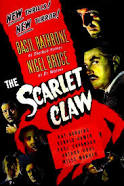
“I’m afraid the happenings in La Mort Rouge wouldn’t interest you Mr. Holmes”
Sherlock Holmes (Basil Rathbone) and Dr. Watson (Nigel Bruce) are at a conference on the occult in Canada. One of the attendees, Lord Penrose (Paul Cavanagh) is from a small village called La Mort Rouge. He receives a message that his wife, Lady Penrose has been murdered. Holmes and Watson are about to return to England when Holmes receives a telegram that Lady Penrose sent to him before her death. She relates that she is in fear for her life and asks for Holmes’ help. Holmes decides to investigate her death.
When they arrive at the village they find that everyone in town is convinced the murder is the work of the legendary monster of La Mort Rouge. The monster roams the marshes around the village. Of course Holmes is skeptical. Watson on the other hand, at one point, sees what he believes is the monster himself. He calls it a ball of fire spitting flames in each direction.
Holmes recognizes Lady Penrose as Lillian Gentry, a former American actress. She had been involved in a scandal years before. An actor named Alistair Ramson killed another actor in a jealous rage over her. Ramson was believed to have been killed in a prison escape two years before. Holmes is of the belief that Ramson is actually alive and living in the village. There are a couple other people that live in the village and have an association with Ramson. Emile Journet (Arthur Hohl) was a guard at the prison that housed Ramson. The other is Judge Brisson (Miles Mander), the judge that passed sentence on him. Both men are terrified that they may be next on Ramson’s list.
“The Scarlet Claw” was released in 1944 and was directed by Roy William Neill. It is sixth of the Universal films but the eighth film of the entire Rathbone/Bruce series. General consensus is that “The Scarlet Claw” is basically a rehash of “The Hound of the Baskervilles”. Even so, it is also considered by many as the favorite of the series. It is one of the four movies that Mrs. Hudson doesn’t appear in. It’s strange that the Canadian marshes look an awful lot like the moors of Great Britain.
The movie is steeped in gothic mystery and atmosphere. Holmes is hired by a dead woman. The murderer is suspected by some to be a legendary monster that glows in the dark. Of course we are talking Sherlock Holmes so even though we are talking monsters, we are talking about a monster of the human kind. It’s unfortunate that Watson is portrayed even more bumbling than usual. This is not the Watson that Doyle created.
Dr John Hamish Watson was born in July 7, 1852 in Stranraer, Scotland. He studied at St Bartholomew's Hospital in London, receiving his medical degree from the University of London in 1878, and subsequently being trained at Netley Hospital as an assistant surgeon in the British Army. He was wounded in Afghanistan at the Battle of Maiwand July 27, 1880 by a jezail bullet. He met Sherlock Holmes in 1881. Holmes was looking for someone to share his flat at 221B Baker St. Watson was married and widowed at least two, perhaps even three times. His first wife was Mary Morstan. They married in 1889. Mary died between 1891 and 1894. He was reportedly married to another woman in 1903. Watson had two children, a daughter Rosamund Mary Watson and a son John Ickes Watson. Dr Watson died of pneumonia July 7, 1930.

